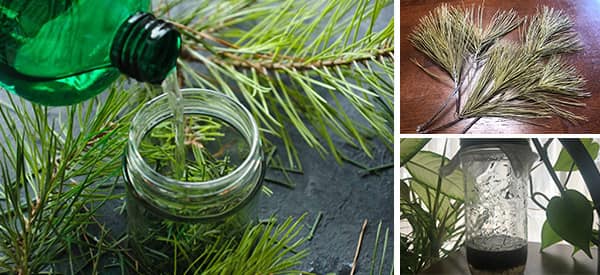
DIY Anti-Viral Pine Needle Tincture
Pine trees are one of the oldest species on the planet, dating back over 150 million years. Just looking at the year-round green foliage of pine trees can elicit feelings of tranquility and comfort, especially if you live in a climate where these trees are the only source of greenery for half of the year.
Likewise, pine trees embody exuberant energy even when days are long and dark, coinciding with the idea that pine cones (which resemble the human pineal gland) symbolize enlightenment and immortality, according to some ancient cultures.
Modern Pine Uses
Nowadays, pine is favored because it grows fast, making it an excellent natural resource for building materials and as a property barrier. But if you’re not a fan of pine for any of the already mentioned reasons, you’ll surely jump the pine fence when I tell you how great it can be for your health.
You can use nearly every part of a pine tree in some way. Pine trees produce different therapeutic components at different times of the year. I will unravel some of the medicinal mysteries surrounding pine and then show you how to put them together to make a potent anti-viral and health-giving tincture.
To evaluate pine’s health benefits, you must break it down into different parts; each part has a lot to unpack. And each component is distinctive and similar simultaneously. But, for this formula, we will use pine needles for time’s sake. You can, however, add other parts of the pine tree to your tincture. I will cover those briefly in the next section.
Pine Needle Health Benefits
Pine needle benefits are extensive and right up there with medicinal mushrooms and other glorified superfoods. They have up to five times the amount of Vitamin C as an orange and contain enormous amounts of Vitamin A and other potent antioxidants. In addition, the natural terpenes in pine needles lend to their antibacterial, anti-microbial, and anti-inflammatory capabilities. These features alone also make this evergreen herb excellent for treating viruses, but honestly… that’s just the tip of the iceberg.
Pine needles are also high in a natural Suramin called Shikimic Acid. Shikimic has anti-platelet-aggregative properties, which can help reduce blood platelet aggregation. In short, this can help prevent respiratory complications during infection. It’s also a potent antiviral and has shown to be competitive with certain influenza medications like Tamiflu. Likewise, pine needle tincture is effective against colds and coughs and can even help loosen chest congestion.
Shikimic and other valuable phytochemicals in pine needles like Eugenol, Linalool, and Terpineol can help bind to and inhibit spike proteins present in some RNA and DNA viruses through a known process as molecular docking. Pine needles also contain many beneficial constituents like quercetin and chlorophyll, commonly used by herbalists to help blood circulation and even treat anemia.
Other Medicinal Components of Pine
Pine Cones Uses: You can use the young green pine cones and more mature pine cones to make a pine cone tincture, but the more immature cones hold more medicinal value. They should be harvested directly off the tree in late spring to early summer once nutrition levels have reached their max. Pine cones contain therapeutic substances, like polyphenols, tannins, phytoncides, essential vitamins, and iodine. Research in pine cone extract suggests they can inhibit the growth of HIV, influenza, herpes simplex, and tumors while boosting immunity and normalizing neurological responses.
Pine Bark Benefits: The inner bark of the pine tree possesses oligomeric proanthocyanidin compounds (OPCs.) OPCs are known for their rich antioxidant content and have been shown to have antiviral, antibacterial, anti-carcinogenic, anti-inflammatory, and anti-aging effects.
Pine Pollen Uses: Pine pollen has assertive anti-inflammatory and antioxidant properties, which help slow aging and diminish inflammatory-related conditions. But perhaps it’s best known for its ability to help regulate hormones in both men and women. It’s also great for workout recovery and for helping relieve depression symptoms.
Solvents
You can use alcohol, vinegar, or vegetable glycerin to make your homemade pine tincture. Vinegar tinctures last for about a year and, well… taste like vinegar. It would be best if you used raw organic apple cider vinegar. Vinegar tinctures are made the same way as alcohol tinctures.
However, glycerin tinctures absorb slowly and are safe for children. Those who don’t want to use alcohol or vinegar can also opt for glycerin. Glycerin tinctures last about 2-3 years. To use glycerin, follow the same steps as the alcohol tincture, except you have to fill your jar one-third of the way full of scalding hot water. Then fill the jar the rest of the way with organic vegetable glycerin and continue to the next step.
Alcohol tinctures last 1-3 years.
Anti-Viral Pine Needle Extract
You will need:
- A mason jar
- Clear alcohol like Vodka or Grain Alcohol (at least 80-proof) OR other solvents
- Enough dried pine needles to fill the jar (and other parts if desired)
- Cheesecloth
- A ring, rubber band or plastic lid
Instructions:
Step 1. Gather your pine needles and place them in your mason jar.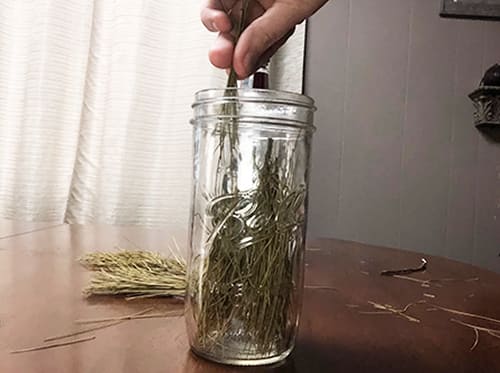
Step 2. Crush the pine needles a bit with something blunt. The point is to break the needles up so they can release their oils. Plus, it makes them easier to cover with solvent.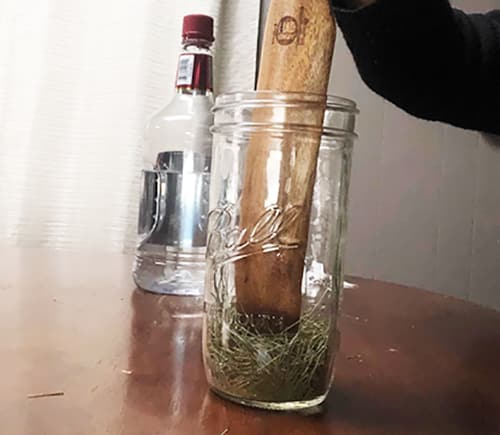
Step 3. Cover the needles with your solvent, giving them about an inch of extra liquid. You will need to watch your liquid levels over the next six to eight weeks and add more if necessary.
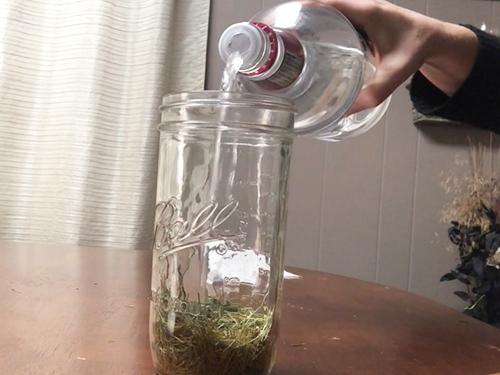
Step 4. Cover the jar with a cheese cloth and screw the ring on “finger tight.” I didn’t use a metal flat top as it might get rusty. To avoid this, you can use a plastic screw on lid instead.
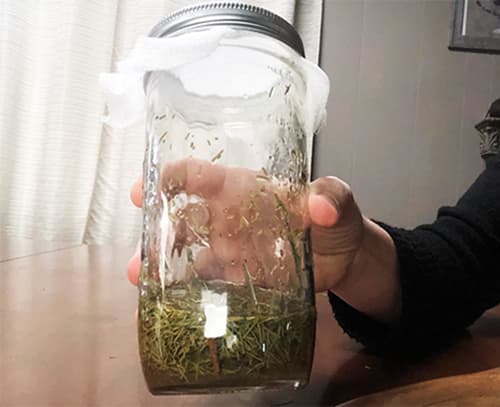
Step 5. Place the jar in a cool dark place for six to eight weeks. Give it a little shake every day.
Step 6. Pour the liquid through the cheesecloth into a storage container. 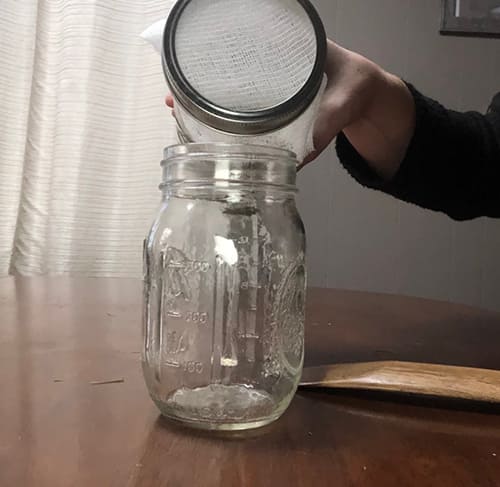
Step 7. Add it to a dropper bottle if you want.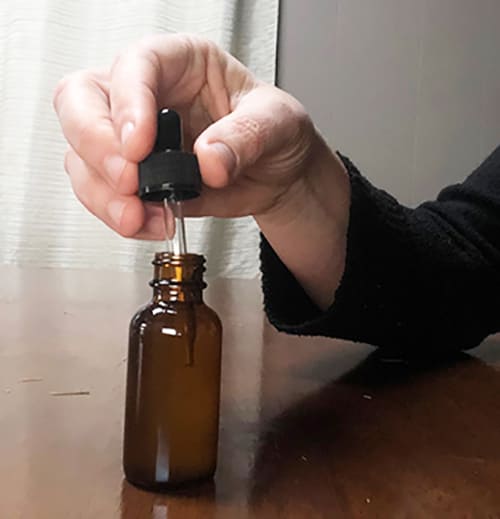
How to use this remedy
Put 6-12 drops under the tongue, 1-3 times daily, hold 30 seconds, then swallow. Alternatively, you can add the tincture to water or tea.
Warnings and Cautions
Women should avoid pine during pregnancy.
A few pines are inedible or toxic, especially “non-true” pines (landscape evergreens).
Some pines to avoid are: Lodgepole pine, Monterey pine, and Norfolk Island pine. The leaves are not toxic, but their rich chemicals can cause uterine contractions that may result in miscarriage. You must be extremely careful not to harvest yew (Taxus spp., Taxaceae), a conifer with poisonous needles.
Make sure that you know your pines well before consuming. A good rule of thumb is to stick with White Pine, common Spruces, Red Wood, Fir Pines, and Scotch Pine.
The Bottom Line
This pine tincture is a must-have in your “herbal medicine cabinet.” There are so many wonderful benefits to be had. I highly recommend educating yourself on the health benefits of pine over and above this article, as it genuinely has some remarkable healing capabilities that I can’t convey in such a short amount of time. Moreover, it’s abundant worldwide. Happy healing!
You may also like:
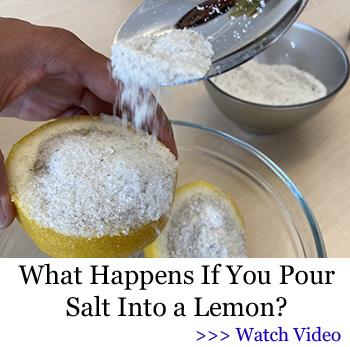 The DIY Turmeric Tonic That’ll Help You Conquer a Cold
The DIY Turmeric Tonic That’ll Help You Conquer a Cold
Nature’s Most Effective Aspirin (Video)
Soothing Elixir For Cold and Flu Season
10 Natural and Easy Remedies for Women’s Health
8 Surprising Ways to Use Pomegranate to Heal From Inside Out

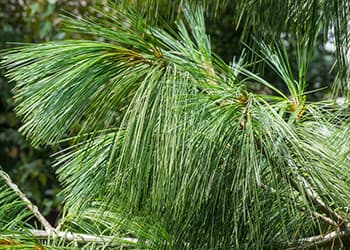
What species of pine do you recommend? I have ponderosa, digger and yellow pine. I also have cedar. Would any of these work?
I’ve read on other sites that ponderosa pine needles should NOT be used.
I have also heard that from quite a few sources
I always use Douglas Fir (pine) because the cones make it super easy to identify.
Neat the bottom of the article it states:
“Make sure that you know your pines well before consuming. A good rule of thumb is to stick with White Pine, common Spruces, Red Wood, Fir Pines, and Scotch Pine”
dig me the white pine, nice subtle flavor
can you use Yellow Pine needles just not sure the difference to white and yellow pine needles I know the yellow pine is a harder wood.?
I want to know the same thing
When is the best time to harvest the needles?
I would like to know this too. And what about making a tea?
Yes, the needles makes a great tea. Put them through a grinder first or crush them and then boil in a pan for 10 mins 🙂
Green needles can be harvested anytime you need them, but they are at their prime (medicinal properties) in late spring. But I have trudged out in the snow to pull needles for my respiratory tea and they have still given great benefits.
Hi Lisa,
Thank you for your interest in our article!
Pine needles can be collected throughout the year! However, new growth in the spring may be less tough and produce more vitamin C.
Many blessings and good health!
Hi, I’m assuming we are to use the flat top along with the ring over the cheese cloth so it doesn’t evaporate, correct? This is unclear. Thank you for such great information.
YES, must be covered completely with the flat top
The picture only shows the cheese cloth.
If this is correct (using the flat top to close the mason jar) what is the purpose of the cheesecloth?
cheesecloth is used as a strainer
Hi Lisa,
Thank you for your question! The author of this recipe didn’t use the metal flat top because it rusts the lids and makes them hard to get off. She only used cheesecloth and added alcohol as needed to the jar. You can put a flat lid on if you want, or use a plastic screw on lid.
Many blessings and good health!
Now I’m completely confused. The photos do not show the flat top. They only show the cheesecloth and the sealing ring. Why would the levels need to be watched and replenished if the canning lid is used? Would the lid be placed outside the cheesecloth?
The article said to watch the level of the vodka to see if you need to add more to keep to covered. I think it only has the cheese cloth, because some would evaporate. If it had the flat lid this wouldn’t be necessary.
I use cheesecloth at the end of my maceration to strain and squeeze the herbs. During maceration I top with lid so I can shake jar periodically to get maximum extraction.
Hi Noelle,
Thank you for your interest in our article!
The author of this recipe didn’t use the metal flat top because it rusts the lids and makes them hard to get off. She only used cheesecloth and added alcohol as needed to the jar. You can put a flat lid on if you want, or use a plastic screw on lid instead.
Many blessings and good health!
White pine? Red pine? Scotch pine? Jack Pine? lots of ‘pine’ trees
I always use Douglas Fir (pine) because the cones make it super easy to identify.
White pine are considered best choice by most, if you have access to them. I’ve planted some for the future, but for now I use long needle and short needle and still enjoy great benefits. Red pine, scotch pine and Jack pine are good. It’s easier to list the pines that are NOT good.
Can you use Pinus radiata?
Hi Sheree,
The needles of this pine are most commonly used to make a green dye. It is best to use White Pine to make this recipe, as it’s easy to identify it correctly.
You can read more about how to identify it in the article below:
https://thelostherbs.com/white-pine/
Many blessings and good health!
Thank you. There’s no Pinus strobus growing in pine plantation (mainly Pinus radiata) in the area where I live in New Zealand, unfortunately. Thanks for your help.
Dear Sheree, I imagine like me you are a resident of Australia or New Zealand. I just happened to remember that a common name for Pinus Radiata is Monterey Pine which is listed in earlier comments as unsuitable.
I read an article by another herbalist that said the white pines are easily identified bc their needles are attached to the stem of the tree in bunches of 5 needles. This was true for my pines which I was relatively certain were white pines….
If you use the flat top with vinegar or alcohol it can corrode the lid. You can use a plastic screw on lid rather than the cheesecloth or if you don’t have it use plastic wrap before adding metal lid.
Hi April,
Thank you for your valuable comment! It is extremely useful for our community and we all appreciate it!
This is true indeed, and the reason why this author didn’t use a metal flat top.
Many blessings and good health!
Thxs for this interesting & informative article! There’s a pine tree in my front yard but I have no idea of what kind it is? Do you have an article on how to identify edible pine trees?
DYI…. I think you meant to say DIY right?
DIY: Do It Yourself.
DYI: Do Yourself In.
Is Thuja pine safe to use ?
Hi Nkoyo,
Thuja Essential Oils are most commonly used for their health benefits. For this recipe: it is best to use one of the species the author of this article recommended: White Pine, common Spruces, Red Wood, Fir Pines, and Scotch Pine.
You can also read our article about White Pine:
https://thelostherbs.com/white-pine/
Many blessings and good health!
How long can you take this for at a time?
Great article. Thank you. Will try with the young cones this spring. Will be my first tincture after reading about these in the BIBLE.
My question is re alcohol, ABV of 80% or 160 proof. since you say at least 80% concentration, also sunny window and not in dark area since most of the time it is put in dark area, and last on metal cover just cheese cloth, thanks
I never knew that there were so many different types of Pine. :-O I was hoping to see pictures of the different pines.
Is concolor fir a good choice?
Yes you shouldn’t put herbs into the sun as it leaches away the medicinal properties which is why tinctures are usually stored in amber bottles to keep the damaging aspects of the sun out.
I’ve heard you can take the pine needles put straight into a pot and bring to boil and shut off and drink like tea, mix raw honey for taste and still get the benefits. True?
Hi Randy,
Thank you for your comment.
You can drink pine needle tea and still reap amazing health benefits.
The downside of brewing tea is that only the water-soluble compounds are extracted into the water.
You can find a pine needle tea recipe, and more useful info about White Pine below:
https://thelostherbs.com/white-pine/
Many blessings and good health!
I would like to know for the extract that instead of using pine needle if I can use the balsam fir? Cause I live in northern Ontario and there is a lot of fir and spruce and less of pine tree.
Thanks
I bought white pine needle tea quite a few months ago that were stored in the fridge in the paper bag it came in – is it too late to make a tincture with them now?
Why dried pine needles rather than fresh off the tree?
Please inform as to the safety/efficacy of ponderosa pine pollen. I’m specifically interested is androgenic adaptogens.
Thanks 🙏🏽